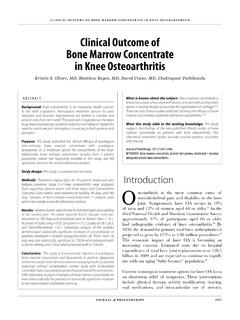Transcription of Core Decompression Augmented With Autologous Bone …
1 Technical NoteCore Decompression Augmented with AutologousBone marrow Aspiration concentrate for EarlyAvascular Necrosis of the Femoral HeadLucas Arbeloa-Gutierrez, , Chase S. Dean, , Jorge Chahla, , andCecilia Pascual-Garrido, :Lack of necessary perfusion to the femoral head can lead to necrosis of the underlying bone (avascularnecrosis) and result in femoral and acetabular surface changes in advanced stages. Numerous treatments have been re-ported in the literature, including nonoperative and surgical procedures. In addition to the standard core Decompression ,we describe the use of bone marrow aspirate to stimulate a healing response and bone grafting, allowing for immediateweight bearing postoperatively.
2 The purpose of this article was to describe our method of core Decompression augmentedwith bone marrow aspirate concentrate and bone grafting for the treatment of early avascular necrosis of the necrosis (AVN) of the femoral head is theresult of decreased bloodflow to the femoralhead, often due to intravascular coagulation of theintraosseous microcirculation. This lack of adequateperfusion can result in necrosis of the bone , micro-fracture, and articular surface collapse in the main risk factors include alcohol and cor-ticosteroids, which are involved in more than 50% ofthe cases. Other risk factors include irradiation, trauma,and sickle cell disease.
3 However, up to 40% of cases percent of total hip replacements(THRs) are the result of the early stages, AVN of the femoral head isfrequently asymptomatic, but it can present as limitedrange of motion and groin pain exacerbated by forcedinternal (AP) and frog-leglateral radiographs are routinely obtained but usuallyappear unremarkable. Magnetic resonance imaging(MRI) is the diagnostic gold standard5and should beperformed in every case of classic AVN presenting withunremarkable radiographs. In 70% of cases, presenta-tion is size and location of the lesion areprognostic factors for disease progression and are bestassessed by diagnosis is crucial for optimaltreatment of left untreated, about 70% to 80%of patients progress to collapse and secondary osteoar-thritis of the treatments have been proposed for AVN of thefemoral head.
4 Nonsurgical treatments include phar-macologic therapies, such as lipid-lowering agents,anticoagulants, vasoactive substances, and bisphosph-onates, and nonpharmacologic therapies, includingextracorporeal shockwave therapy, pulse electromag-netic therapy, and hyperbaric oxygen range from core Decompression to total Decompression is a widespread and acceptedtechnique for the treatment of early AVN of the femoralhead. Good results have been reported when per-formed in the initial or pre-collapse phases (Ficat stages0 through II)5; however, less-than-desirable resultshave been reported when performed in advancedstages (Ficat stage III or IV).8It has been suggested thatone reason for poor healing in some patients is thatthere might be insufficient osteoprogenitor cells in thefemoral head to support the repair of the necroticFrom the Department of Orthopedics, Complejo Hospitalario de Navarra( ), Pamplona, Spain; Steadman Philippon Research Institute ( , ), Vail, Colorado, ; and Department of Orthopedics, University ofColorado ( ), Aurora, Colorado, authors report that they have no conflicts of interest in the authorshipand publication of this December 15, 2015.
5 Accepted February 4, correspondence to Cecilia Pascual-Garrido, , Department ofOrthopedics, University of Colorado, University of Colorado Hospital,Anschutz Outpatient Pavilion, 1635 N Aurora Ct, Aurora, CO 80045, 2016 by the Arthroscopy Association of North America2212-6287/151187/$ Techniques, Vol-,No-(Month), 2016: pp , bone marrow aspiration concentrate (BMAC) therapy has been proposed as an adjuvanttherapy to core Decompression . Several studies havereported better results when core Decompression iscombined with BMAC, as compared with results withcore Decompression , core Decompression has been per-formed with multiple drill holes in the femoral required patients to be noneweight bearing for6 weeks postoperatively.
6 The proposed surgical tech-nique uses a single drill hole and a 6-mm cannulatedtrocar rod that perforates the exact area of necrosis andis Augmented with BMAC and bone allograft. Thisprocedure allows patients to bear weight as toleratedimmediately after surgery. The purpose of this technicalnote was to describe the method of core decompressionaugmented with BMAC and bone grafting for thetreatment of early AVN of the femoral TechniqueDiagnosisDiagnosis is based on the patient s history and clinicalpresentation. A history of corticosteroid use and alcoholabuse can help guide the clinician toward a often complain of pain, limping, or limitedmobility, especially in internal rotation.
7 However, it isnot uncommon for this disease to present only as oc-casional isolated discomfort. In the early stages, AP andfrog-leg lateral radiographs are usually unremarkableor they may show cysts and sclerosis that can beobserved in the anterior and superior part of thefemoral head. The Ficat classification is the mostcommonly used system to stage AVN of the hip(Table 1).16,17 Moreover, MRI should be performed inall cases of suspected AVN because it can showfindingsnot evident on plain and ContraindicationsCore Decompression is indicated in the pre-collapsestages of AVN (Ficat stages 0 through II).18It shouldnot be performed in patients with collapse of thefemoral head (Ficat stage III or IV).
8 Patient PositioningThe patient is positioned supine on a fracture table(Hana Table; Mizuho OSI, Union City, CA) with bothfeet secured in traction boots (Fig 1). A second option isto place the patient supine on a radiolucent anesthesia is used for induction. InternalTable ClassificationStagePainRadiographic Findings0 (preclinical)None NormalI (pre-radiographic) NormalII A (pre-collapse) Changes in bone trabeculae withsclerosis or cystic changesII B (pre-collapse) Presence of crescent signIII (early collapse) Normal joint space, presence of crescentsign, osteochondral fracture withsequestrumIV (osteoarthritis) Collapse of head, decreased joint space,flattened contourFig patient is positioned supine on a fracture table withboth feet secured in traction boots and internally rotated.
9 Aright hip setup is bone marrow is obtained percutaneously throughthe use of bone marrow aspiration needles bilaterally. (ASIS,anterosuperior iliac spine.)Fig PerFuse rod is placed over the skin to determinethe anteroposterior skin markings on a right hip. (ASIS,anterosuperior iliac spine.)e2L. ARBELOA-GUTIERREZ ET of both feet is performed by positioning thepatella facing straight up. It is necessary to ensure thatAP and lateral views can be taken with afluoroscopebefore preparing the patient. Draping should be per-formed in a sterile manner that provides exposure ofthe anterosuperior iliac spine proximally and continuesbelow the knee distally (Video 1).
10 bone marrow AspirationBone marrow aspiration is performed proximal to theanterosuperior iliac spine. Iliac bone marrow isobtained percutaneously through the use of a bonemarrow aspiration needle (MarrowStim; BiometBiologics, Warsaw, IN) introduced manually or withlight mallet blows. The bone marrow aspiration needleruns parallel between both cortices of the iliac crest. Atotal of 100 mL of bone marrow is aspirated using a60-mL or 10-mL syringe, with the 10 mL syringe beingpreferable. Each syringe will be preloaded with 10 mLof heparin (1,000 U/mL) to avoid coagulation and clotformation (Fig 2). It is also important to prime the bonemarrow aspiration needles with anticoagulant to avoidclot Sample CentrifugationThe bone marrow aspirate samples are placed in acentrifuge (Drucker Diagnostics, Port Matilda, PA) andspun for 15 minutes at a speed of 3,200 DecompressionCore Decompression is initiated while the bloodsample is processing.









